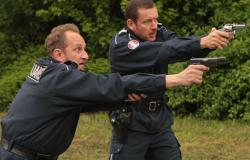17th Heavy Mechanized Brigade photo
On Aug. 6, a powerful Ukrainian force invaded Kursk Oblast in western Russia and captured what is now a 250-square-mile salient anchored by the town of Sudzha. On Nov. 7, an equally powerful Russian force counterattacked—aiming to drive toward Sudzha along the main road threading from Zelenyi Shylakh on the western edge of the salient.
In more than two weeks of hard fighting, the Russians have made barely any progress. The Zelenyi Shylakh-Sudzha road is littered with the evidence of their failure: dozens of destroyed and abandoned armored vehicles.
But the Russians aren’t about to quit, and their biggest push may be imminent. The Kremlin has bolstered its roughly 50,000-strong corps in Kursk with thousands of North Korean troops along with elements of two Russian airborne divisions, the 76th and 106th, plus the 83rd Air Assault Brigade and the rebuilt 155th Naval Infantry Brigade. These units and others are poised just northwest of the road through Zelenyi Shylakh.
“In the nearest future we expect a massive and, in my humble opinion, successful Russian advance at my flank in Kursk region,” wrote Kreigsforscher, a Ukrainian marine corps drone operator who has been supporting the Ukrainian corps in Kursk.
Russian President Vladimir Putin has given his general until early February to eject the Ukrainians from western Russia. But the real deadline, it seems, is the Jan. 20 inauguration of U.S. President-elect Donald Trump, who has vowed to end Russia’s wider war on Ukraine but whose offhand proposals hinge on an unenforceable ceasefire that would freeze the front line in place.
Putin should be happy with any ceasefire that hands him control of 11 percent of Ukraine. But Putin would be unhappy to trade away that sliver of Kursk, however tiny. The clock is ticking. “Two Russian VDV divisions, one VDV brigade and one marine brigade will launch an assault with a lot of maneuvers,” Kriegsforscher warned, using the Russian acronym for “airborne.”
The 20,000-strong Ukrainian force in Kursk—drawn from the 41st and 47th Mechanized Brigades, the 82nd and 95th Air Assault Brigades and the 17th Heavy Mechanized Brigade, among other units—is bracing for the renewed Russia attack. The 17th Heavy Mechanized Brigade, a reorganized former tank brigade, has been holding the line just north of the road to Sudzha.
The brigade’s recent actions underscore the sheer violence of the escalating battle. It’s extremely dangerous to move along the front line without armor protection. So the 17th Heavy Mechanized Brigade has deployed some of its 60 T-64BV tanks as improvised supply vehicles.
In one chaotic mission on or before Nov. 16, one of the 42-ton, three-person T-64s hauled a load of food to an entrenched infantry unit—and then immediately opened fire on nearby Russians with its 125-millimeter main gun. As the tank was withdrawing back to its forest base, a Russian drone struck, damaging but not stopping the tank. “The combat assignment was completed,” the 17th Heavy Mechanized Brigade reported.
The danger to Ukrainian troops will only increase as the Russian counterattack intensifies. If there’s any reason for optimism among the outnumbered Ukrainians, it’s that Russian forces in and around Kursk are subject to a relentless campaign of precision deep strikes by Ukrainian air force bombers and Ukrainian army rocket batteries, respectively firing British-made Storm Shadow cruise missiles and American-made Army Tactical Missile System ballistic missiles.
On Monday, the Ukrainians struck a sprawling Russian arms depot west of Kursk with eight ATACMs. On Wednesday, they hit a Russian command post in Kursk with 10 Storm Shadows. The deep strikes could fray the supply lines to the regiments, brigades and divisions in Kursk—and disrupt their command and control.
But even when it’s undersupplied and poorly-led, the Russian force in Kursk is still much bigger than the Ukrainian force. Mass will count for a lot in the coming mechanized clash.






